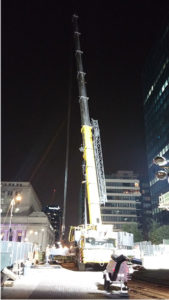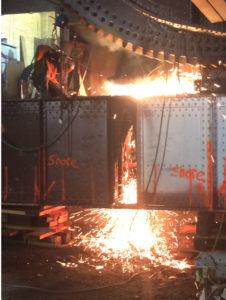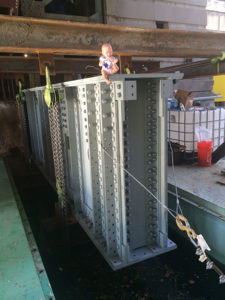Insights • March 2, 2017
Rehabbed Adams Street Bascule Bridge
As of February 2017, the improved Adams Street Bascule Bridge is now ready for prime time. After the February 24, 2017 completion of the reconstruction project that commenced in April 2015, motorists now experience a smoother ride and Metra passengers have a sound platform from which to catch their rush hour trains.
Located just to the east of Chicago Union Station, the Adams Street Bridge is one of two primary crossings serving the station between the west side of the Chicago River and Chicago’s Loop. The viaduct to the west of the bridge spans across the north terminal tracks of Chicago Union Station. Supporting more than 40,000 pedestrians and 20,000 cars and buses per day, the bridge was last rehabilitated in 1996 and was due for a major overhaul.

Viaduct Girder Removal
Built at the same time as the bascule bridge, the viaduct was well beyond its useful life and needed to be replaced as well. In late 2015, Walsh Construction was awarded a $34 million contract to rehabilitate the bascule bridge and replace the viaduct over Union Station to the west. “With our wealth of experience in bascule bridge design, Milhouse was retained by Walsh to perform construction-related engineering services,” said Stan-Lee Kaderbek, Milhouse’s Vice President of Civil and Transportation.
Milhouse is unique in Chicago, as it is only one of a few firms that performs this kind of intricate and comprehensive bridgework. Stan has served in the industry for almost 40 years, in the public and private sectors. A former Deputy Commissioner Bridges and Commissioner of Buildings for the City of Chicago for 12 years, Stan has been involved in “every moveable bridge of the in the city,” which number in the thirties.

400,000-pound crane
Chicago’s Adams Street Bascule Bridge over the South Branch of the Chicago River was built in 1927 by the Fitzsimons & Connell Dredge & Dock Company of Chicago. The bridge is officially classified as a Chicago style trunnion bascule bridge, or Chicago- Type, Double Leaf, Trunnion Bascule Bridge, and is owned and maintained by Chicago’s Department of Transportation.
The Chicago style trunnion bascule was developed by the Chicago Department of Public Works at the turn of the 19th Century. The two movable bridge leaves pivot about a fixed trunnion, or fulcrum, much like a teeter totter. The word “bascule” is French for “seesaw.” The leaves on each side of the river have large counterweights to balance the span across the river. Each leaf of the Adams Street Bridge is 120 feet long, weighs more than 3 million pounds and measures 240 feet trunnion to trunnion.
The bascule bridge rehabilitation work was extensive due to extensive deterioration of many of the main structural elements of the bridge.
Milhouse’s work included:

Removal of Longitudinal Girder
• Evaluation of the existing bridge structures to support equipment loadings, including a crane weighing over 400,000 pounds to remove viaduct girders
• Temporary earth retention – often the first stage of construction — at track level of Union Station to allow for the replacement of the viaduct support columns
• Development of the sequence of demolition for all major structural members
• Review of the balance of the bridge to allow removal and replacement of floor beam 0-0 at the center break between the leaves
• Design of temporary construction, such as temporary centerlocks between the leaves, to provide continuity of load transfer between the leaves to allow vehicles to cross the bridge
• Design of alternative repairs that simplify construction
The Milhouse team’s “biggest challenge” was the development of a procedure to allow the replacement of the west leaf’s longitudinal girder, according to Stan. The longitudinal girder is used to support the bridge leaf’s trunnion bearing. Each longitudinal girder supports over 1 million pounds of load.
To allow the replacement of the longitudinal girder, Milhouse developed a shoring and jacking system to support the bridge leaf’s counterweight. Shoring is a supporting structure that carries the load of the counterweight and maintains safety for workers while construction proceeds. The shores support the counterweight which allowed Milhouse to raise the counterweight to remove the load from the longitudinal girder. Over 1.2 million pounds of jacking force was used to lift the counterweight. With the load removed, the existing longitudinal girder could then be removed and the new girder installed.

New Longitudinal Girder being Installed
One of the last items of work Milhouse designed for Walsh was a procedure to open the movable leaves without the use of the electric motors. Typically, the bridge is operated with a 50 horsepower motor. Because Walsh was replacing the bridge control and electrical system, there was no power to open the bridge leaves. Milhouse devised a procedure using chain falls to pull on the counterweight to open the bridge. Since the bridge leaf is balanced to within 5,000 pounds of being balanced, the leaf can be easily moved using this method. The same procedure was used to lower the leaf.
While not the preparation of design documents used to bid for the rehabilitation of the bridge, construction engineering has unique challenges and is much more immediate in terms of the impact of our work on the outcomes of construction. Work crews depend upon our quick response and solutions to solve construction issues. Very often, delays mean that workers are not productive and waste valuable time. The designs we develop are typically not found in any textbook and draw upon the collective engineering knowledge of our staff to develop and implement. The Milhouse staff involved in the work include Stephen Long, Vince Scarpa and Arturo Pereda who prepared calculations, verified loadings and developed plans for the work.
Crystal Fencke contributed to this article.
